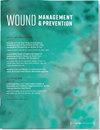一次性负压创伤治疗在16例足科门诊慢性创伤患者中的应用。
IF 1
4区 医学
Q4 DERMATOLOGY
引用次数: 0
摘要
背景一次性机械负压创伤治疗(dNPWT)有助于门诊治疗下肢创伤。目的:我们评估了足病诊所16名患者的dNPWT使用情况。方法患者在2019年10月31日至2021年12月16日期间接受治疗。所有患者接受dNPWT,每2至3天换药一次。记录人口统计学、基线伤口和随后的伤口访视数据以及治疗情况。评估伤口愈合结果。结果患者平均年龄为59.6±8.9岁。患者合并症包括营养不良、糖尿病和高血压。伤口类型包括6个糖尿病足溃疡、9个外科伤口和1个压力性损伤。基线时,平均伤口年龄为15.6周,平均面积为5.5cm2,平均体积为3.3cm3。从出现到dNPWT结束的平均时间为45.5天。在此时间段内,伤口肉芽组织数量(81%)有所改善,面积减少(63%),体积减少(69%)。到治疗结束时,大多数患者(88%)显示出76%至100%的伤口床覆盖率为健康肉芽组织。其余12%显示肉芽组织覆盖率<76%。结论在这项回顾性研究中,16名患者中有14名在dNPWT治疗期间伤口面积、体积和肉芽组织数量有所改善。本文章由计算机程序翻译,如有差异,请以英文原文为准。
Use of disposable negative pressure wound therapy in 16 podiatry clinic patients with chronic wounds.
BACKGROUND
Disposable mechanical negative pressure wound therapy (dNPWT) can help manage lower extremity wounds in the outpatient clinic.
PURPOSE
We assessed dNPWT use in 16 patients at a podiatry clinic.
METHODS
Patients were treated between October 31, 2019 and December 16, 2021. All patients received dNPWT with dressing changes every 2 to 3 days. Demographics, baseline wound and subsequent wound visit data, and treatments were recorded. Wound healing outcomes were assessed.
RESULTS
Average patient age was 59.6 ± 8.9 years old. Patient comorbidities included poor nutritional status, diabetes, and hypertension. Wound types consisted of 6 diabetic foot ulcers, 9 surgical wounds, and 1 pressure injury. At baseline, the average wound age was 15.6 weeks, average area was 5.5 cm2, and average volume was 3.3 cm3. The average time from presentation to end of dNPWT was 45.5 days. In this timeframe, wounds improved in granulation tissue amount (81%), reduced in area (63%), and reduced in volume (69%). By the end of treatment, a majority of patients (88%) displayed 76% to 100% wound bed coverage with healthy granulation tissue. The remaining 12% showed <76% coverage with granulation tissue.
CONCLUSIONS
In this retrospective study, 14 of 16 patients displayed improvement in wound area, volume, and granulation tissue amount during dNPWT treatment.
求助全文
通过发布文献求助,成功后即可免费获取论文全文。
去求助
来源期刊

Wound management & prevention
Nursing-Medical and Surgical Nursing
CiteScore
1.70
自引率
8.30%
发文量
41
期刊介绍:
Information not localized
 求助内容:
求助内容: 应助结果提醒方式:
应助结果提醒方式:


